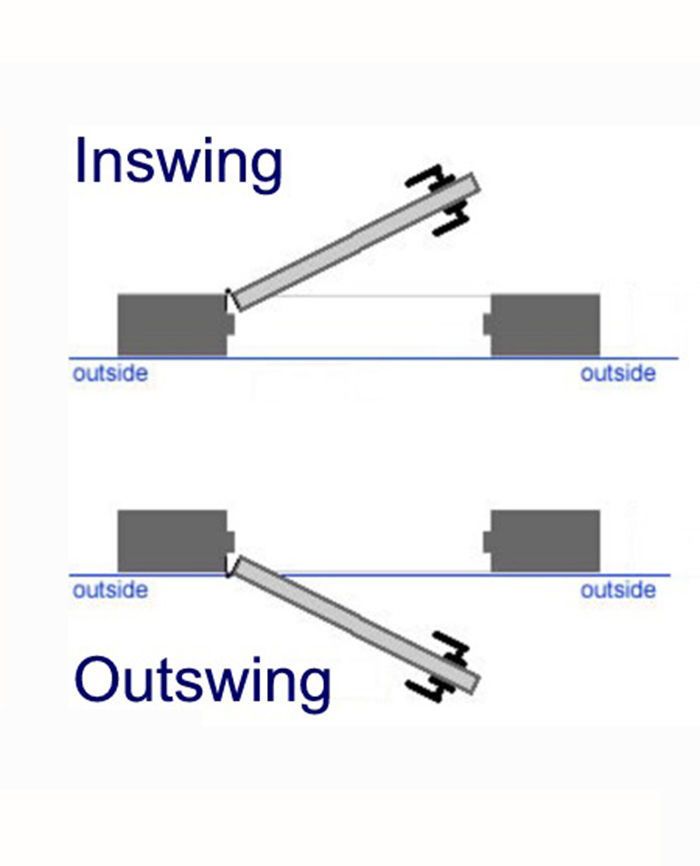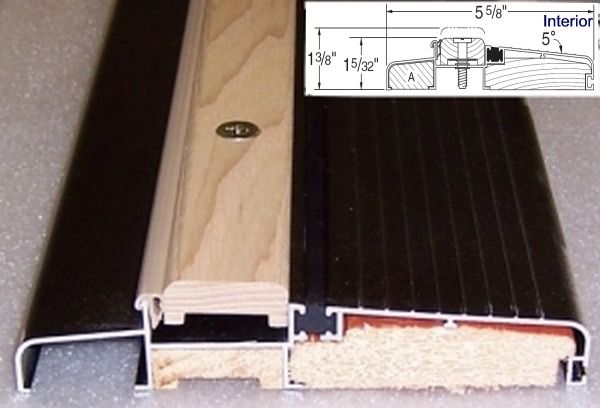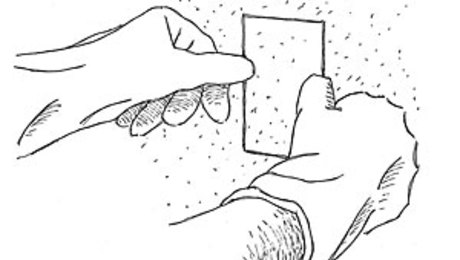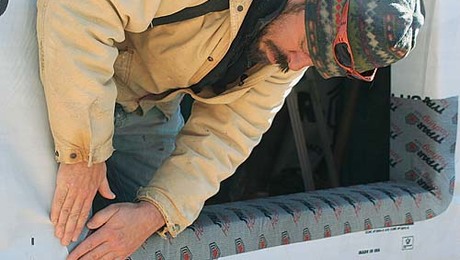
Inswing exterior doors dominate the residential market, but a better case can be made for an entry door that swings out rather than in. Outswing doors are more secure, airtight and durable than inswing style doors. I think the building codes should be changed to favor outswing doors in all but a few instances. This is a pretty strong statement that will raise a few neck hairs so if you don’t like this assessment let me know why.
Here’s how I see the inswing and outswing doors stacking up:
The threshold
The bottom of an inswing door relies on a sweep gasket to seal out drafts and water. Friction takes its toll on door sweeps and it isn’t long before they wear. Sure, adjustable threshold strips can make up for the wear but when was the last time you saw a homeowner try to adjust one? To get a good seal you’ll need friction between the sweep and the threshold — friction means the door will be harder to open.
The door bottom on an inswing door hovers over the highest point on the threshold so any wind-driven water is headed inside unless there’s an ample roof over the landing. You can install a mechanical door gasket that drops when the door is closed or an interlocking weatherstrip. They’ll work great for a couple years and then become a maintenance issue. Another solution to the leaky threshold problem is a storm door (which of course swings outward).
The threshold of an outswing door, on the other hand, has a positive stop just like the jamb. The threshold stop creates a difficult path for water and, coupled with a compression gasket, helps to seal out wind and water. Since the gasket doesn’t rely on friction, an outswing door is easier to open and close.
Durability
This issue piggybacks on the threshold design. Keep the water out and there’s less chance for rot. I’ve pulled out many inswing doors with rotted subfloors, popping tile and deteriorated hardwood due to repeated water leaks. Outswing doors generally don’t suffer the same problem.
Security
The first red flag most people throw out when I recommend an outswing door is the security risk. They feel the exposed hinge pins are a weak spot thieves can exploit. That may have been the case many years ago but security style hinges are now common on outswing and many inswing doors. Tabs or studs on the hinges prevent the door panel from being removed even when the pins are popped out. The tabs and studs are either integrated into the hinge leaves or can be retrofitted to old hinge models. And some hinges also have special threaded pins that resist extraction without a special tool. So with the hinge issue off the table, an outswing door is actually more secure than an inswing door.
Inswing doors are a cinch to kick in even when deadbolts and deep-screwed strike plates are used. Outswing doors on the other hand are next to impossible to kick-in and unlikely to be yanked out on the strike side (unless a thief chains the door handle the bumper of a waiting car).
The main downside to outswing doors is availability. None of my local lumberyards stock outswing frames so they need to be ordered. One practical downside I can see is when there is an insufficiently sized exterior landing to permit someone to stand while opening or closing the door. But aside from the landing problem, why mess with a door design that has an inherent flaw when an outswing door is superior?
More on exterior doors:
The Ins and Outs of Exterior Doors — Get a crash course in choosing an entry door, from basic features to premium upgrades.
Installing Exterior French Doors — Part of a video series on the complete installation process, from preparing the rough opening to the installation of flashing, hardware and screen doors.
Choose a Quality Entry Door — Options include wood, steel, and fiberglass, with cost, aesthetics, and maintenance all important concerns in selecting one over the other.
Build a High-Performance Exterior Door — How to make a beautiful entry door for an energy-efficient home from common building materials.
Fine Homebuilding Recommended Products
Fine Homebuilding receives a commission for items purchased through links on this site, including Amazon Associates and other affiliate advertising programs.

Reliable Crimp Connectors

8067 All-Weather Flashing Tape

Handy Heat Gun






























View Comments
I have an out-swing door that I installed on my garage-shop for security reasons. That said, I hate it.
First, it is difficult to close and lock. It seems that PULLING to close an out-swing door tight is a bit more cumbersome than PUSHING to close an in-swing door. I suppose substituting my knob for a handle could make it a bit easier but still not as easy as an in-swing.
Additionally, there is no possibility of adding a storm/screen door to an out-swing. During the summer with my in-swings in the house it is nice to leave the door open and let the summer breezes cool the house through the screen door. During winter the storm adds insulation value to the door opening and a second layer of wind resistance.
Last, I worry about SNOW. While not a concern in the sunny states, here in Michigan it wouldn't be uncommon to have a couple to a few feet of snow fall in one over-night. How fun would it be to begin your morning by finding out you are trapped in your home?
So, while an out-swing door may provide [slightly] better weather protection and certainly better security is it really worth it?
One more issue I would like to point out is that the chances of any home getting burglarized is actually quite slim; In my area of rural michigan I have a 0.3% chance of being burglarized but even in Detroit (the most crime-ridden city in America?) the chances of a house or business being burglarized is still only 2%. You are actually more likely to be assaulted in Detroit. Not to mention, when it comes to theft, doors only keep out the honest. If someone wants in, they'll find a way.
Google search: "bump keys" or "break in through garage door" and if you are really worried about being robbed your best bet is to install curtains and get a dog.
DC
Try opening an outswing door carrying a bag of groceries and a baby. Outswings are great if your hands are empty...not so much if you are carrying things into the house.
Of course the counter argument is that inswing doors are a pain when you are carrying thing OUT of the house but the difference is you have a climate controlled, clean and dry place to set things down to open the in swing door.
BTW, there are screen applications you could employ on an outswing door. Roll screens are what I am thinking about in particular but there is no reason beyond asthetics that you couldn't mount even a regular screen door inboard of an outswing door.
Closing and locking either an inswing or outswing door shouldn't be an issue if the strike is set properly. Both door types need to lock in the pull direction - Outswing when you are in the house and Inswing when you depart. No difference there.
Loaded down with kids and baggage would be even more of an issue for inswing doors with storm doors than an outswing door. Electric strike plates work great to ease the problem whether it's an outswing or inswing door.
High snow areas do have an egress issue with outswing doors. I recently opened my basement inswing door only to have a 3 ft drift of blowing snow tumble in - Covered or double entries are the way to go there.
I was just searching online for information about outswing doors when I happily discovered your article. I really appreciate your opinion regarding inswing/outswing doors and the facts that you use to support your personal leaning toward an outswing door.
Having created a website about an outswing door, I've personally gathered LOTs of facts about them, have opened and closed them hundreds of times, have many, many pictures of them in both commercial and residential applications, and am thoroughly impressed with their performance numbers. Also, I've had no problem with opening, closing, or locking an outswing door, as Dreamcatcher mentions. However, I've never lived with one, myself... although I have plans for them in my next house.
That's another reason I was happy to find this site. The people who've commented on your article so far have made valid points that I'm seriously considering... the snow issue, for one, since I live in North Dakota and have lots of snow. However, I must say that most homes and buildings on the website that I created are in the far northern states, and I didn't come across anyone complaining about that issue... probably because most of them have covered entrances of some kind.
As far as the ventilation issue goes in summer, I've seen the retractable screens that cussnu2 mentions, and they seem to work fine with an outswing door. One that I'm thinking of is mounted to the interior jamb of the door, the screen has tracks at the head and sill and rolls out of sight into a compact metal canister. You just pull out the screen and attach it magnetically to the opposite jamb for full ventilation.
Again, thank you for all the great information. I will definitely be coming back again and again to this site... looking for facts and thoughtful opinions with lots of details.
All good points but....I have lived with out-swing doors for over 15 years in South Florida and have found them as good as any in-swing door. Florida hurricane codes have made the out-swing door the preferred choice due to their superb impact and wind performance. You can get hurricane code in-swing doors but because they need to be reinforced they are more expensive and harder to find.
There's also a social/psychological consideration to the door swing. When greeting a visitor, an in-swing door allows the occupant to better control the degree of interaction. Swing the door open and say "its great to see you again, come on in!" verses opening it a few inches with "may I help you..?" I think most people would prefer this capability over the possible benefits of an out-swing door. I haven't studied it but this factor may account for the tradition of an in-swing door in residences.
Concerning security - What about when your doorbell rings and you don't know who is on the other side of the door. An In-swing door affords you the option of having your foot at the base of the door or a security chain to prevent the door from fully opening. An out-swing door does not allow this. A foot or security chain is not an impenetrable barrier but it is better than nothing.
Concerning pets, large dogs in particular- An in-swing door restrains a large dog much easier than an out-swing door.
I think there are benefits to both styles but careful consideration is required. As noted above, snow drifts blocking the quick egress of an out-swing door would be my main concern.
JO
what if you want to leave an outside swing door open? then you've got the door exposed to the weather.
Phantom screens can be put on an outswing door. They go on the inside and are really nice. I have one...great product.
In Ontario, where I live, all commercial doors must be outswing for fire code compliance. I have had several businesses and have never had a issue with snow build-up. Fresh snow isn't really that hard to push out of the way. If outswing commercial doors work well, there shouldn't be too many issues with residential ones. Also, Jotter notes you can't put a security chain on an outswing door. Why not? It would still allow you to open the door far enough to talk with someone without them being able to yank the door open.
I recently replaced my inswing patio door with an outswing unit, here's why: all the reason's in the article. High winds and rain would push and flex the inswing door causing water damaged flooring, rotted sill and subfloor, and the bottom sweep gasket would tear up needing periodic replacement. I love the new outswing door BUT...there is one important drawback...WIND. If it's blowing from a bad direction and you open the door, whoosh, it wants to take off like a beach umbrella in a squall. This is even more a problem when your carrying stuff and yet even more a problem when guests or kids are opening the door. "Hang onto the door please", "watch out for the wind", "careful, hold that door handle".
You guys are nuts. Outswing doors have two basic deficiencies that disqualify them for most cases, in my opinion. These are: 1) you cannot have a screen door, and 2) you can jimmy them in a heartbeat! They are not secure. The hinges are not the problem if designed right; the problem is the crack that you can stick a wrecking bar in and pop the door open. This crack is not visible on the other side.
I now live in FL and all the doors are outswinging due to hurricane regs (harder to push in the door if outswing), but nearly EVERY door I have looked at has marks where someone has tried to pry it open. EVERYWHERE I have ever lived in the past, and every place I have stayed in many years of travel, had in almost every case, an in-swinging door, and I can guarantee you it is because they are harder to jimmy or pry open. I hate the outswinging doors here in Florida.
I'll bet I could open any front door in my neighborhood in 2 minutes with a good wrecking bar. Not so easy if the door is in-swinging. However, a good metal door and metal frame may be OK if outswinging.
Right when you mentioned the outward hinges the first thing I was going to ask was about the security issues - Thanks for clarifying! My business was broken into several years ago and it was because I had installed a door with the hinges facing outward. Criminals apparently have an eye for this, and even though I had a moderately expensive surveillance system (one of the no-name brands like these) they still were able to break in and steal a number of valuables from my establishment.
Out-swinging was the perfect solution for my application where the rear door was at the landing to the down stairs steps. Form follows function.
Another "happy with", high usage door is in-swinging but without a storm door so I wasn't constantly opening two doors. This Southern exposer door was a special-order metal on the outside and wood on the inside.
I appreciate everyone's thoughts and ideas. I'm replacing my old inswing french door with a brand new outswing french door because I believe it is the perfect solution of form and function. I have ordered a fiberglass outswing door that is double pane low e glass. It is going on an upper back deck with no egress to the downstairs---security is of no issue, probably won't even lock it most of the time. This will offer me better weather resist. while creating a better space inside my family room. I plan on putting wooden stops on the zero entry deck to keep the doors from blowing out too far. I also plan on putting commercial style door-kick props to keep the doors propped open.
All said, you have to consider usage, space, frequency, etc when determining the right door and material for each application. Inswing doors certainly have their place, but in my instance the outswing door is simply the better option for this entry. I have six exterior entries to my home and this will be the only outswing.
After my neighbor did some work on his doors in Ottawa, I've become interested in mine. I like what Dreamcatcher said because I was initially thinking of getting an outswing, simply because it seems in my mind more of a hassle for a burglar. That's a small deterrent though. In the end, dog probably trumps door in that regard anyway. No, I think I'll go for a french inswing. Should be an interesting project.
Hi Mike,
I am so glad I found your article.
I am due for a new front door and I want it to swing out and did some research and couldn't find many more then you recommend a outswinging door. I am from Sweden and no doors has inswing.
I don't see any benefits with a inswing door at all.
Outswing;
Wind, water, theft, fire, space etc.
Why take away space from the house sqft. to have a door swing in...
If anyone seen cops kicking in doors, very easy, try to do that on a outswing door. And if fire I want to get out ASAP.
Another thing people taking about is to have a screen door, WHY?? I had one on the house I bought some years ago and when coming home with grocery I opened the screen dor and set it in lock position and when I wind the door closed hard on my back, I ripped it out after that. Just open the windows if you want a draft.
The only negative thing I can see with a outswing door is when lots of snow been falling during night and you can't get the door to open, but how many time does that happen? Happy I live in Florida:)
Thanks again Mike for a nice article about this issue.
Ps. Mike, what is the name for the built in security hinges so it can't be removed or high wind can't grab the door. Are the pins welded?
I put a few outswing doors on my new house thinking they would save me some floor space. However, I wouldn't ever do it again as every time the doors are open and a breeze blows, the door acts like a sail and either slams the door shut or flings it hard open and tweaks the hinges. I ended up having to buy rather expensive door hold opens to try to prevent this issue. They work for light breezes but not for a good gust of wind. I'd definitely stick with the inswings next time.
security a out swing door is very hard to kick in
For heaven's sake, whatever you believe, don't encourage building codes to take a side and restrict people's freedom. Let builders decide what to do. Remember that owner-builders have to follow the same rules, and they should be able to decide for themselves what kind of doors they want.
You fail to mention that an outswing door can be blocked by someone or something outside. A good snow storm will lock a person into their house with an outswing door--imagine a fire at the time the door is blocked with snow. You would die. A 2x4 jammed into the stair railing in front of an outswing door will also trap you in your home. In short, an outswing door is an invitation to mother nature, to fire and to thugs to trap you in your home. It is just an AWFUL idea.
An inswing door might not be as structurally secure, but it can be made as best as possible through modern manufacturing techniques, and at least, it will never, ever trap you inside your own home, with no method of egress.
We live in SC, outswing doors are a real problem here.
First, if the hinges are not SS, then they will rust in less than 1 year. The builder/developer sees no problem with that.
Second, without a storm door to protect the door & the wooden jam, they will rot, even with Sherman ext paint.
NOW , I have to spend the big bucks to get a rot free jammed door, & have the fun of replacing it. Also I will buy a storm door to help protect the new installation, As I DON'T want to have to replace this door again.. PP developer & his PP contractors(RS Parker)
I know this article is old, but I found it via searching for my issue with a new commercial door I ordered, for my residence. I'm trying to secure my basement exterior door. The cheap wood frame door there now is too much of a risk.
Anyway, I ordered a 300 lb steel pre-hung commercial door, and told the company I wanted in-swing. I was surprised when it was delivered that the attachment screws that go through the frame and into my foundation masonry, are on the OUTSIDE of the house. I suppose this is because they expect all these commercial doors to be out-swing, not in-swing.
So, anyone who happens to come up to my new door with a 1/4" socket on a cordless driver can remove the door in under 3 minutes.
They are not going to take this door back, so any ideas on recovery would be appreciated, otherwise this was a waste of $1,300.
I thought of backing the part of the frame that is inside the house with pressure-treated lumber, then driving flat-head masonry screws through that. I also thought of filling the recessed channel in the frame on the outside where those screws are exposed, with concrete.
Or I can install it as an out-swing but then it swings in the wrong direction and cuts off traffic flow to the staircase nearby.
Arrrghhh...
Thank you for this article! As products continue to develop, it's a good idea to revisit the question. I have a new client who wants to consider an outswing door so I decided to hunt for opinions. Thank all of you who have replied with thoughtful comments!
One specific reason I've been slightly jaded on outswing doors is the "landing". I live in Colorado and since water can defy gravity for just over 3" in ice, we tend to have a minimum step outside of 4". (I watched a video about how this happens years ago and can't find it now.) The International Residential Code (IRC) section 311.3 talks about landings. The way I read 311.3.2, I can have a landing that is up to 7.75" down or even with 2 steps. Many years ago, 311.3.2 was interpreted by an inspector that my outSWING french patio doors couldn't have that drop (or steps). He said if it the door didn't SWING, I could step immediately. I was forced to put an at-grade landing so the entire door swing was at grade. Maybe that inspector was wrong or maybe that's one for the "con" column. I can ask my current inspector what he'll say before I buy the door on new projects, but that was an ugly costly, client un-happy experience I don't want to repeat.